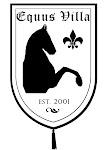The most common in-air transport vehicle is a special container known as an Airstable. Looking very similar to a horse trailer without wheels, one unit holds three horses and locks onto a standard shipping pallet. Some have movable side panels within the box to accommodate different size horses.
The horses arrive at the airport via regular ground horse transportation such as a van or trailer. The airport will provide a quiet place to load horses into the Airstable. It is then moved by truck or tractor to the plane and moved into place in the cargo hold by cargo elevator and rollers on the floor of the plane. Some planes have the horse transport stalls built into the aircraft. Commercial flights may be restricted to certain airports, and they may be routed through a hub city, increasing the travel time substantially.
Once loaded, it’s not possible for the horses get out of the shipping boxes at all during the flight. According to one shipping agent, most flights are 6 to 10 hours, and rarely is a flight longer than 14 hours. The horses have room within the transport boxes to move a couple of steps back and forth and, as mentioned, some air boxes have adjustable panels. Most airlines do not take more than 6 containers, so 18 horses are usually the maximum head count allowed per flight. Weight as well as space is a factor in determining the cargo allowed.
Although shipping by air can be stressful for some horses, particularly due to the noise and vibrations with certain aircraft, for the most part the flight itself is not much more stressful than it is for their human counterparts. Sedatives may be administered to problem horses, but horses are generally supplied with plenty of hay to keep them occupied. Although well-ventilated, the Airstables don’t have windows, just access doors for their human handlers to check on them. As with human passengers, the take-off and landings may be more problematic for some, but once the plane is in the air, it’s generally not as rough as an over-the-road trailer ride for the horse. Cross-oceanic flights often fly at higher altitudes than shorter domestic flights, so turbulence is not a major issue except in rare circumstances.
Colic is the most common ailment during flights, and is difficult to deal with due to space constraints. Management via strict feed and water monitoring generally reduces the risk for all but the most unusual cases.






3 comments:
I'll never forget the (highly dramatized) scene in International Velvet when one of the horses panics during the flight to the Olympics.
In the top photo, don't the horses look a bit on the skinny side?
Hi Julie - you forgot to credit your source, Equine Chronicle.
http://www.equinechronicle.com/riding-and-training/ask-the-professional/modern-pegasus-horses-flying-internationally.html
Post a Comment